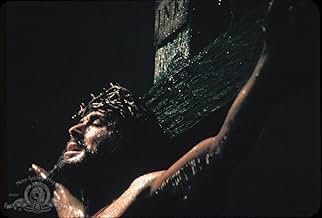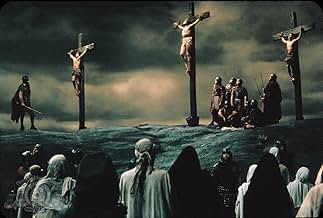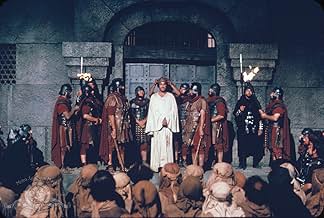Um filme épico que narra a vida e o ministério de Jesus Cristo.Um filme épico que narra a vida e o ministério de Jesus Cristo.Um filme épico que narra a vida e o ministério de Jesus Cristo.
- Indicado a 5 Oscars
- 1 vitória e 6 indicações no total
Enredo
Você sabia?
- CuriosidadesTelly Savalas shaved his head bald for his role as Pontius Pilate; he kept it shaved for the rest of his life.
- Erros de gravaçãoDifferences from the source material are not considered to be goofs, especially when relating to dramatic decisions. Many historical inaccuracies also get a pass, especially when caused by reliance on religious and/or artistic traditions.
- Citações
Jesus: Do not weep for me; weep for yourselves, and for your children. For a time is coming when men will say "blessed are the barren, the wombs that never bore a child." And they will say to the mountains "fall on us," and to the hills "cover us," for if these things are done when the wood is green, what will happen when it is dry?
- Versões alternativasOriginal Cinerama version ran 260 minutes, subsequently cut over the years. The shortest version runs 141 minutes. Numerous versions have been shown on television. Network television print has only the main cast credits at the beginning and the technical credits at the end shown page-by-page (not "rolled up" as most prints), including a credit for "Cinerama". The most common version of the film shown today runs 195 minutes with all the credits rolled up at the beginning, and the end titles showing only the words "Released through United Artists". That particular version has been available on home video and cable TV.
Avaliação em destaque
Without a doubt, the life, death, and resurrection of Jesus Christ is the most difficult story to ever put on the screen. More blood and ink have been spilled over this one man than any other human being that ever walked this planet, so there really can't be a definitive film on his life that will satisfy everyone. But during the first half of the 1960s, director George Stevens (A PLACE IN THE SUN; SHANE; GIANT) toiled to at least come close in that regard. The result was THE GREATEST STORY EVER TOLD. At a cost of twenty million dollars, it was one of the most expensive films Hollywood had released in that era. At an original length of four hours and twenty minutes, it was one of the longest movies ever. It was also critically savaged and was only a modest commercial success, though not an expensive flop like CLEOPATRA had been.
Although it doesn't stick to ALL the facts of the Good Book, GREATEST STORY does an exquisite job at depicting Jesus life and persecution, his miracles, his death, and his eventual resurrection. Utilizing a massive tome of a script that he co-wrote with James Lee Barrett and Carl Sandburg, among others, Stevens filmed much of the film on location in the Glen Canyon region along the Arizona/Utah border, with the Colorado River as a stand-in for the River Jordan (a move for which Stevens was sharply criticized). Aided by veteran cameraman Loyal Griggs (THE TEN COMMANDMENTS), he also shot scenes in this movie that must rank as being among the most brilliantly filmed ever, including Lazarus' resurrection, and Jesus' being baptized in the River Jordan by John the Baptist.
One particular aspect about GREATEST STORY that continues to raise eyebrows and much ire to this day is the fact that Stevens cast much of Hollywood's acting elite in what were essentially walk-ons. This tactic had been done extensively before (THE LONGEST DAY; HOW THE WEST WAS WON), and would be done countless more times in the ensuing decades. To me, the flaw in this technique insofar as this movie goes is not the fact that Stevens succumbed to that temptation, but the fact that the roles he placed some of his actors in were ones they probably weren't cut out to play.
Given the whole weight of the world being placed on him, Max von Sydow did quite an impressive portrayal of Jesus in this film. I would have to rank this as one of the single greatest performances in cinematic history; his credibility (even with the Swedish accent) in the role is, to me, unimpeachable. Stevens also scored by giving Charlton Heston (no stranger to Biblical epics he) the role of John the Baptist, and it still ranks as one of Heston's best. Telly Savalas, years away from "Kojak", makes for a chilling Pontius Pilate. Claude Rains is a supremely nasty King Herod; and Donald Pleasance, with HALLOWEEN still a decade and a half in his future, makes for a deliciously unpleasant Satan.
In other areas, Stevens' all-star casting ranges from sublime (Dorothy McGuire; Roddy McDowall; Sidney Poitier; David McCallum; Jose Ferrer; Victor Buono) to strange (Russell Johnson; Jamie Farr; Sal Mineo; Shelley Winters). But it is in his casting of John Wayne as a Roman centurion at the Crucifixtion that Stevens went overboard (thus the reason for my giving GREATEST STORY an '8' rather than a '10'). To this day, it's hard not to notice the Duke looking out of place as a Roman, and harder still not to groan at the flat way he utters his line ("Truly, this man was the Son of God").
Still, despite the slightly questionable casting and the obvious extreme length of the film, Stevens has indeed fashioned as great a film as there has ever been on a story that has fascinated, frustrated, and even torn the world apart for over two thousand years. How others view it is up for themselves to decide. I myself think that, though slightly imperfect, THE GREATEST STORY EVER TOLD still lives up to its title.
Although it doesn't stick to ALL the facts of the Good Book, GREATEST STORY does an exquisite job at depicting Jesus life and persecution, his miracles, his death, and his eventual resurrection. Utilizing a massive tome of a script that he co-wrote with James Lee Barrett and Carl Sandburg, among others, Stevens filmed much of the film on location in the Glen Canyon region along the Arizona/Utah border, with the Colorado River as a stand-in for the River Jordan (a move for which Stevens was sharply criticized). Aided by veteran cameraman Loyal Griggs (THE TEN COMMANDMENTS), he also shot scenes in this movie that must rank as being among the most brilliantly filmed ever, including Lazarus' resurrection, and Jesus' being baptized in the River Jordan by John the Baptist.
One particular aspect about GREATEST STORY that continues to raise eyebrows and much ire to this day is the fact that Stevens cast much of Hollywood's acting elite in what were essentially walk-ons. This tactic had been done extensively before (THE LONGEST DAY; HOW THE WEST WAS WON), and would be done countless more times in the ensuing decades. To me, the flaw in this technique insofar as this movie goes is not the fact that Stevens succumbed to that temptation, but the fact that the roles he placed some of his actors in were ones they probably weren't cut out to play.
Given the whole weight of the world being placed on him, Max von Sydow did quite an impressive portrayal of Jesus in this film. I would have to rank this as one of the single greatest performances in cinematic history; his credibility (even with the Swedish accent) in the role is, to me, unimpeachable. Stevens also scored by giving Charlton Heston (no stranger to Biblical epics he) the role of John the Baptist, and it still ranks as one of Heston's best. Telly Savalas, years away from "Kojak", makes for a chilling Pontius Pilate. Claude Rains is a supremely nasty King Herod; and Donald Pleasance, with HALLOWEEN still a decade and a half in his future, makes for a deliciously unpleasant Satan.
In other areas, Stevens' all-star casting ranges from sublime (Dorothy McGuire; Roddy McDowall; Sidney Poitier; David McCallum; Jose Ferrer; Victor Buono) to strange (Russell Johnson; Jamie Farr; Sal Mineo; Shelley Winters). But it is in his casting of John Wayne as a Roman centurion at the Crucifixtion that Stevens went overboard (thus the reason for my giving GREATEST STORY an '8' rather than a '10'). To this day, it's hard not to notice the Duke looking out of place as a Roman, and harder still not to groan at the flat way he utters his line ("Truly, this man was the Son of God").
Still, despite the slightly questionable casting and the obvious extreme length of the film, Stevens has indeed fashioned as great a film as there has ever been on a story that has fascinated, frustrated, and even torn the world apart for over two thousand years. How others view it is up for themselves to decide. I myself think that, though slightly imperfect, THE GREATEST STORY EVER TOLD still lives up to its title.
- virek213
- 22 de out. de 2003
- Link permanente
Principais escolhas
Faça login para avaliar e ver a lista de recomendações personalizadas
- How long is The Greatest Story Ever Told?Fornecido pela Alexa
Detalhes
Bilheteria
- Orçamento
- US$ 20.000.000 (estimativa)
- Tempo de duração4 horas 20 minutos
Contribua para esta página
Sugerir uma alteração ou adicionar conteúdo ausente

Principal brecha
What is the streaming release date of A Maior História de Todos os Tempos (1965) in Australia?
Responda




































